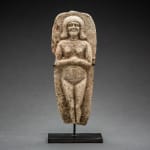Old Babylonian Clay Moulded Plaque of a Standing Deity, 2000 BCE - 1700 BCE
baked clay
height 17.8 cm
height 7 in
height 7 in
LO.1159
The Old Babylonian period describes south Mesopotamia in the period about 2000-1600 BC. The early years saw a number of important states dominating the region: Isin, Larsa, Eshnunna and, from...
The Old Babylonian period describes south Mesopotamia in the period about 2000-1600 BC. The early years saw a number of important states dominating the region: Isin, Larsa, Eshnunna and, from 1894 BC, Babylon. Babylon was ruled by a dynasty of Amorite kings. The sixth ruler was Hammurapi, who defeated the other southern states and expanded his control into north Mesopotamia. On the death of Hammurapi the empire gradually shrank over about 150 years. Nonetheless, Babylon remained an important power until it was sacked by the Hittite king, Mursili I, in about 1595 BC. During the Old Babylonian period literary activity flourished with scribes composing and recording religious, poetic and 'scientific' works in Sumerian and Akkadian cuneiform. Perhaps the most famous monument is the stele of Hammurapi, now in the Musée du Louvre, Paris.
Ceramic plaques of this sort were mass-produced from moulds and represent a form of art available to a wide audience. The casting of plaques was a simple and inexpensive way to produce relief images, since numerous plaques could be made from a single mold. They have been excavated in temples as well as household shrines in private homes. Their subject matter varies widely, including religious images, mythological and erotic scenes, and representations of rulers and gods.
Our plaque depicts a standing naked female figure clasping her hands underneath her breasts, her hair reaching the shoulders, her neck adorned with necklace. Images of women are not generally common, though it has been possible to learn something about the status of women in ancient Mesopotamia from documents dating from 2400 BC until around 1700 BC. Queens often controlled their own estates, had their own administration and played an important role in the economic life of the state. Wives of governors were also active in the textile and other industries. Women could own land, orchards, slaves, oxen and silver. It is clear that women had the same legal rights as men, and that they could go to court to protect them. They could apparently act independently, buying and selling houses, and could act as guarantor for another person. Further down the social scale, the main occupation of women was weaving. Texts also mention the number of their children, who were probably taken to work, as many of them are suckling babies. Boys were separated when grown up and the girls raised to become weavers like their mothers. Many, but not all, were slaves (as a result of warfare). A great number were possibly connected with a-ru-a, an institution where objects, animals or people were donated to temples.
Reference: For a three-dimensional bust representing a very similar female figure in the British Museum see: J.E. Reade, 'Early Mesopotamia', British Museum Magazine: the Journal of the British Museum Friends, 6 (1991), pp. 15-18, p.17.
Ceramic plaques of this sort were mass-produced from moulds and represent a form of art available to a wide audience. The casting of plaques was a simple and inexpensive way to produce relief images, since numerous plaques could be made from a single mold. They have been excavated in temples as well as household shrines in private homes. Their subject matter varies widely, including religious images, mythological and erotic scenes, and representations of rulers and gods.
Our plaque depicts a standing naked female figure clasping her hands underneath her breasts, her hair reaching the shoulders, her neck adorned with necklace. Images of women are not generally common, though it has been possible to learn something about the status of women in ancient Mesopotamia from documents dating from 2400 BC until around 1700 BC. Queens often controlled their own estates, had their own administration and played an important role in the economic life of the state. Wives of governors were also active in the textile and other industries. Women could own land, orchards, slaves, oxen and silver. It is clear that women had the same legal rights as men, and that they could go to court to protect them. They could apparently act independently, buying and selling houses, and could act as guarantor for another person. Further down the social scale, the main occupation of women was weaving. Texts also mention the number of their children, who were probably taken to work, as many of them are suckling babies. Boys were separated when grown up and the girls raised to become weavers like their mothers. Many, but not all, were slaves (as a result of warfare). A great number were possibly connected with a-ru-a, an institution where objects, animals or people were donated to temples.
Reference: For a three-dimensional bust representing a very similar female figure in the British Museum see: J.E. Reade, 'Early Mesopotamia', British Museum Magazine: the Journal of the British Museum Friends, 6 (1991), pp. 15-18, p.17.



